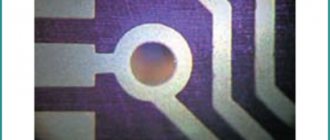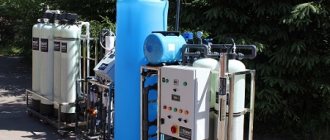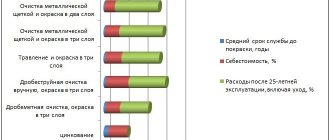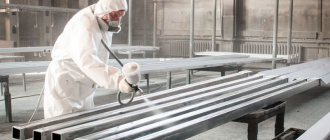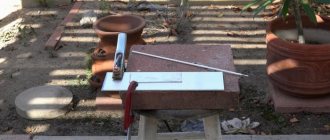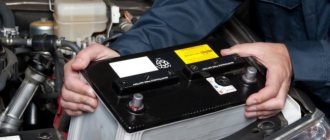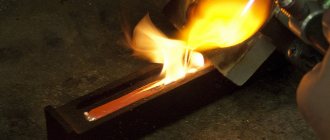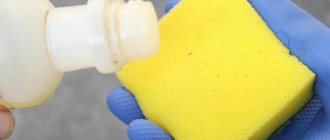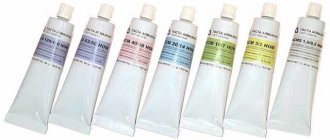Etching with ferric chloride - Help for a beginner - Help for a beginner - Home
For the PCB layout I used the Sprint-Layout 4.0 program. A very good free program with a Russian interface and extensive printing capabilities. Downloaded from the link https://vrtp.ru/screenshots/161_Plata.zip. After 15-20 minutes we get a wired board for SMD components. You can download my diagram here (file board.lay) To make boards, I use “acetone” technology instead of “ironing”. In addition to melting, laser printer toner dissolves very well in acetone and at the same time sticks to copper (and not only to it). In order not to buy half a liter of acetone, you can buy nail polish remover, which the fair half of humanity uses to remove polish from nails. You can take it from your beloved girlfriend, wife, mother, niece (underline as appropriate). First, a mirror image of the board layout (fortunately the program allows) is printed on a coated sheet. Magazines work well for this purpose, although fax paper can also be used.
We need: a circuit board printed on a laser printer, acetone, cotton wool, foil PCB sanded with fine sandpaper. Next, cut out the printed image and wipe the copper with cotton wool generously moistened with acetone. We wait until it dries. We apply the toner to the copper image and moisten the paper with the same cotton wool until we see the board pattern “appear” through it. You need to wet the entire image evenly. You also can’t overfill it too much, otherwise it will float.
Wet the paper with acetone. After the image has “developed,” you need to let the acetone evaporate. In this case, “the image will disappear.” Next, wet the dry sandwich made of PCB and the image stuck to it under the paper generously with cold water. The paper will get wet and begin to “hump”, this means that’s enough. Next, we tear off the paper, but the toner remains. There will be some paper lint on the toner, which needs to be removed by rubbing it with your hand.
After the workpiece dries, it will turn white. This is from acetone. It's OK. Next you need to etch away the unnecessary copper. You can use several recipes for this. One option is a solution of copper sulfate and table salt in water in the ratio of a tablespoon of copper sulfate to two tablespoons of salt in half a liter of water. Disadvantages: in such a solution the process takes a long time, about 2.5 hours, even if the temperature is maintained high or the concentration of the components is increased. Advantages: availability, copper sulfate can be bought at any hardware store, salt - without words. The second option is a solution of ferric chloride in water in a ratio of 1:2. Etching temperature ~ 60-70ºС. To maintain a high temperature, I place the jar of solution in the bathtub and run hot water from the shower hose to wash the jar. Disadvantages: harmful fumes that are released during the etching process, as well as the fact that if the solution gets on your hands or bathtub, yellow stains remain, so you need to act more carefully. Advantages: in a ferric chloride solution, etching occurs faster ~ 20 minutes, provided that the temperature is maintained high. I used the second method.
Before etching, cut off the required part of the future board with metal scissors and throw it into the solution. During etching, use plastic tweezers to remove the board from the solution and observe the process. After etching is complete, the finished board should be rinsed with water and dried.
The process of assembling the board does not raise any questions. A soldering iron with a thin tip, plus solder paste and low-melting tin, minus trembling hands, and in 20 minutes we get the finished product. After soldering, we use the same acetone to wash off the remaining paste from the board.
radioshema.ucoz.org
Ferric chloride (ferric chloride)
Normative documents
TU 6-00-05763458-129-91 “Anhydrous”,
GOST 4147-7 “6-water”
Chemical formula
FeCl3 – anhydride,
FeCl3 × 6H2O - ferric chloride hexahydrate
Appearance
Iron chloride crystalline - black-brown, or dark red, or violet in transmitted light, green in reflected light, crystals or leaves with a metallic sheen. Iron chloride itself is quite highly hygroscopic, binds moisture from the air and forms a 6-aqueous crystalline hydrate.
Specifications
| Indicator name | TU 6-00-05763458-129-91 "Anhydrous" | GOST 4147-7 “6-water” | |
| Clean (h) | Pure for analysis (analytical grade) | ||
| Appearance (not regulated) | Purple crystalline powder with a dark green tint | Soft crystalline mass or pieces of yellow-brown color | |
| Mass fraction of ferric chloride, % | ≥ 95 | ≥ 60 | ≥ 60 |
| Mass fraction of ferric chloride, % | ≤ 0,2 | ≤ 0,005 | ≤ 0,002 |
| Mass fraction of water-insoluble impurities, % | ≤ 4,4 | ≤ 0,005 | ≤ 0,01 |
| Mass fraction of arsenic, % | ≤ 0,001 | ≤ 0,0005 | ≤ 0,0005 |
| Nitrates, % | — | ≤ 0,03 | ≤ 0,010 |
| Sulfates, % | — | ≤ 0,03 | ≤ 0,005 |
| Phosphates, % | — | ≤ 0,25 | ≤ 0,003 |
| Copper, % | — | ≤ 0,05 | ≤ 0,003 |
| Zinc, % | — | ≤ 0,005 | ≤ 0,002 |
| Lead, % | — | ≤ 0,05 | ≤ 0,02 |
| Potassium, % | — | ≤ 0,10 | ≤ 0,06 |
| Sodium,% | — | ≤ 0,10 | ≤ 0,02 |
| Calcium,% | — | ≤ 0,03 | ≤ 0,03 |
| pH of 5% aqueous solution | — | ≥ 1,6 | 1,5-2,5 |
Application
- Aqueous solutions of ferric chloride are used mainly as a coagulant in sewage and industrial wastewater treatment plants, as well as in the treatment of activated sludge.
- Ferric chloride is an excellent odor remover by binding hydrogen sulfide.
- Due to its specific properties, ferric chloride has proven itself as a coagulant for treating wastewater from meat processing plants, poultry factories, and food production plants, for example, it is used to remove oil from wastewater from oil and fat factories.
- It is used in metallurgical and machine-building plants.
- Ferric chloride is used in the purification of wastewater from leather and fur enterprises from chromium compounds.
- Aqueous solutions of ferric chloride have mild etching properties, so they are used in the electronics industry and instrument making for etching printed circuit boards, copper foil and metal parts before electroplating.
- Ferric chloride is used in the production of building materials as an additive to Portland cement to accelerate the setting process. The water-cement ratio (W/C) is recommended within 0.4 – 0.5. The addition of ferric chloride allows you to increase the W/C value. The addition of ferric chloride increases the strength of concrete. Ferric chloride solution is also used as a component of the raw material composition for the manufacture of sand-lime brick; waterproofing additive to the solution during construction work.
- Ferric chloride is used as a catalyst in organic synthesis processes, in the production of heat-resistant resins and the oxidation of petroleum bitumen, as well as in organochlorine synthesis
- Ferric chloride is an energetic chlorinating agent, so it is used for the selective extraction of certain ore components.
- With the help of ferric chloride, natural waters in water treatment systems are clarified;
- The consumption of ferric chloride is 30 g per cubic meter. meter of wastewater.
Advantages
- high rate of deposition of various impurities
- low cost
- During coagulation, loose flakes of a large surface are formed with excellent sorption activity, due to which suspended substances (large microorganisms, plankton cells, sludge, plant remains), colloidal particles, as well as some of the pollutant ions associated on the surface of these particles are included in the structure.
Container, transportation and storage
Anhydrous ferric chloride is packaged and transported in sealed steel barrels (drums), inside which it is additionally packaged in a plastic bag to avoid contact with air and moisture (ferric chloride anhydride is very hygroscopic). Ferric chloride hexahydrate is packaged in polyethylene canisters of 20 or 40 kg.
Special properties
Iron chloride itself is quite highly hygroscopic, binds moisture from the air and forms a 6-aqueous crystalline hydrate. A non-volatile substance, but when interacting with water it emits caustic fumes. Work must be carried out in the fresh air or in a well-ventilated room. Contact of the solution with the skin and mucous membranes leads to irritation and can cause dermatitis. Non-flammable, fire and explosion proof.
Ferric chloride is a reagent for water purification.
ferric chloride produced is used to treat industrial and wastewater.
The problem of industrial and waste water treatment is one of the most important tasks of environmental protection. Coagulation is one of the common methods of wastewater treatment. The essence of the coagulation method lies in the interaction of substances polluting wastewater with mineral coagulants. Ferric chloride is most often used as coagulants which, as a result of hydrolysis, forms poorly soluble iron hydroxide Fe(OH)3. During the formation of this hydroxide, inorganic and organic impurities are captured with the formation of loose flakes, which can be easily removed from the treated wastewater. The resulting flakes with a size of 0.5–3.0 mm and a density of 1001–1100 g/l have a very large surface with good sorption activity. During the process of their formation and sedimentation, suspended substances (silt, plankton cells, large microorganisms, plant remains, etc.), colloidal particles and that part of the pollutant ions that are associated on the surface of these particles are included in the structure. The high rate of deposition of hydroxide flakes determines the advantage of ferric chloride over aluminum sulfate. The process of sludge sedimentation with the help of ferric chloride proceeds faster and deeper, in addition, ferric chloride has a beneficial effect on the biochemical decomposition of sludge. The consumption of ferric chloride is 30 g per cubic meter. meter of wastewater. Chemical wastewater treatment reduces the content of insoluble impurities to 95% and soluble impurities to 25%.
When treating wastewater, microorganisms and toxic compounds contained in the water are destroyed by sodium hypochlorite .
Sodium hypochlorite can be used to treat wastewater containing ammonium salts, phenolic compounds, and mercury. The degree of purification reaches 99.9%.
As a result of studies conducted on the effectiveness of disinfectants used in the food industry, sodium hypochlorite was rated as the most effective and economical product. It has shown high effectiveness against almost all types of plant cells, spores and bacteria. Typically, a solution containing 30 – 40 mg/l of active chlorine is used.
Ferric chloride is also used as a catalyst in the processes of organic synthesis, oxidation of petroleum bitumen, and in the production of heat-resistant resins. It is an energetic chlorinating agent and can therefore be used for the selective extraction of individual ore components.
Aqueous solutions of ferric chloride have mild etching properties, so they are used for etching printed circuit boards, copper foil and metal parts before electroplating.
The use of ferric chloride as an additive to Portland cement to accelerate the setting process is well known. The water-cement ratio (W/C) is recommended in the range of 0.4 - 0.5. The addition of ferric chloride allows you to increase the W/C value. The addition of ferric chloride increases the strength of concrete.
Technical characteristics of ferric chloride solution.
1. Mass fraction of ferric chloride - at least 40%;
2. The density of the solution at 20 °C is not less than 1.41 g/m3. cm;
3. Mass fraction of ferric chloride - no more than 1%;
4. Mass fraction of water-insoluble substances - no more than 2%;
5. Mass fraction of hydrochloric acid – no more than 1.5%.
Regulatory documentation: TU 2152-081-56856807-08
